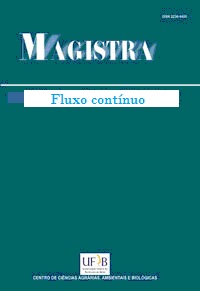Operational analysis of the semi-mechanized harvesting in eucalyptus stands in south Tocantins
Resumo
Abstract: This work aimed to operationally analyze the semi-mechanized forest harvesting activity for charcoal production in the forest cultivation in the state of Tocantins. The study was conducted in an experimental area of the farm “Vale Verde”, located in the municipality of Aliança do Tocantins-TO. Was evaluated or semi-mechanized harvesting system composed by crawler tractor, chainsaw, stump truck and farm tractor with attached trailer. The same evaluated in mechanical availability, economical and efficient. The results show that a reduction activity takes longer, consuming 85% of the downed duty cycle, within a work cycle of 74% consumed tracking and delimbing element processing activities and required 46% extraction or item element processing activities. of activity time. All activities selected mechanical availability below 80%. The highest operational efficiency value found was 85% in felling activity and the lowest in activity extraction with 51%. The values selected in this study, serving as a basis for producers in the region, establish the operational planning of semi-mechanized forest harvesting activities.
Key words: Curves system, Study of times and movements, Operational efficiency.
Downloads
Referências
Allman, M., et al. (2017). Soil moisture content as a predictor of soil disturbance caused by wheeled forest harvesting machines on soils of the Western Carpathians. Journal of Forestry Research, 28 (2), 283-289. DOI: 10.1007/s11676-016-0326-y.
Anderson, N., & Mitchell, D. (2016). Forest operations and woody biomass logistics to improve efficiency, value, and sustainability. Bioenergy Research, 9 (2), 518-533. DOI: 10.1007/s12155-016-9735-1.
Barnes, R.M. (1999) Estudo de movimentos e de tempos: projeto e medida do trabalho. (6. ed ., 635p). Rio de Janeiro: E. Blucher.
Bicknell, J.E., Struebig, M.J., & Davies, Z.G. (2015). Reconciling timber extraction with biodiversity conservation in tropical forests using reduced‐impact logging. Journal of Applied Ecology, 52 (2), 379-388. DOI: 10.1111/1365-2664.12391.
Chaudhary et al. (2016). Impact of forest management on species richness: global meta-analysis and economic trade-offs. Scientific Reports, 6 (23954). DOI: 10.1038/srep23954.
Dimou, V., & Milios, E. (2015). Harvest-inflicted wounds on residual trees. Wood Research, 60 (6), 995-1004.
Diniz et al. (2017). Manutenção preventiva como determinante para redução de custos de manutenção de um feller buncher. Biofix Scientific Journal, 2 (2), 43-47. DOI: 10.5380/biofix.v2i2.54954.
Engler, B., Becker, G., & Hoffmann, S. (2016). Process mechanization models for improved Eucalyptus plantation management in Southern China based on the analysis of currently applied semi-mechanized harvesting operations. Biomass and Bioenergy, 87, 96-106. DOI: 10.1016/j.biombioe.2016.02.021.
Fardusi, M.J., Chianucci, F., & Barbati, A. (2017). Concept to practice of geospatial-information tools to assist forest management and planning under precision forestry framework: a review. Annals of Silvicultural Research, 41 (1), 3-14. DOI: 10.12899/asr-1354.
Fiedler, N.C., Carmo, F.C.A., Minette, L.J., & Souza, A.P. (2017). Operational analysis of mechanical cut-to-length forest harvesting system. Revista Árvore, 41 (3), e410301. DOI: 10.1590/1806-90882017000300001.
Garren, A.M., Bolding, M.C., Aust, W.M., Moura, A.C., & Barrett, S.M. (2019). Soil Disturbance Effects from Tethered Forwarding on Steep Slopes in Brazilian Eucalyptus
Plantations. Forests, 10 (9), 721. DOI: 10.3390/f10090721.
Gonçalves, S.B., et al (2016). Efeito da profundidade de trabalho na qualidade da operação de subsolagem para implantação florestal. Revista Árvore, 40 (1), 29-37. DOI: 10.1590/0100-67622016000100004.
Lijewski, P., et al. (2017). Fuel consumption and exhaust emissions in the process of mechanized timber extraction and transport. European Journal of Forest Research, 136, 153-160. DOI: 10.1007/s10342-016-1015-2.
Linhares, M., et al. (2012). Eficiência e desempenho operacional de máquinas harvester e forwarder na colheita florestal. Revista da Pesquisa Agropecuária Tropical, 42 (2), 212-219. DOI: 10.1590/S1983-40632012000200007.
Lopes, E. S., et al.(2017). Variables influencing working time and skidder productivity in wood extraction. Nativa, 5 (4), 298-302. DOI: 10.5935/2318-7670.v05n04a12.
Malinen, J., et al. (2016). Variation in age, annual usage and resale price of cut-to-length machinery in different regions of Europe. International Journal of Forest Engineering, 27 (2), 95-102. DOI: 10.1080/14942119.2016.1171964.
Nascimento, A. C. N., et al. (2011). Avaliação técnica e econômica da colheita florestal com Feller-buncher. Cerne, 17 (1), 9-15. DOI: 10.1590/S0104-77602011000100002.
Obi, O.F., & Visser, R. (2017). Operational efficiency analysis of New Zealand timber harvesting contractors using data envelopment analysis. International Journal of Forest Engineering, 28 (2), 85-93. DOI: 10.1080/14942119.2017.1313489.
Oliveira, D., Lopes, E. S., & Fiedler, N. C. (2009). Avaliação técnica e econômica do Forwarder em extração de toras de pinus. Scientia Forestalis, 37 (84), 525-33.
Peloia, P.R., & Milan, M. (2010). Proposta de um sistema de medição de desempenho aplicado à mecanização agrícola. Engenharia Agrícola, 30 (4), 681-91. DOI: 10.1590/S0100-69162010000400012.
Ramage, M.H., et al. (2017). The wood from the trees: The use of timber in construction. Renewable and Sustainable Energy Reviews, 68 (1), 333-359. DOI: 10.1016/j.rser.2016.09.107.
Salmeron, A. (1980). A mecanização da exploração florestal (Circular técnica, n. 88, 10p). Piracicaba: IPEF.
Santos, H. D., et al. (2018). Sistema brasileiro de classificação de solos. Centro Nacional de Pesquisas de Solos (5 ed., 353p). Rio de Janeiro: Embrapa Solos.
Silva, E. N., et al. (2010). Avaliação técnica e econômica do corte mecanizado de Pinus sp. com harvester. Revista Árvore, 34 (4), 745-753. DOI: 10.1590/S0100-67622010000400019.
Downloads
Publicado
Como Citar
Edição
Seção
Categorias
Licença
Autores que publicam nesta revista concordam com os seguintes termos:- Autores mantém os direitos autorais e concedem à revista o direito de primeira publicação, com o trabalho simultaneamente licenciado sob a Licença Creative Commons Attribution que permite o compartilhamento do trabalho com reconhecimento da autoria e publicação inicial nesta revista.
- Autores têm autorização para assumir contratos adicionais separadamente, para distribuição não-exclusiva da versão do trabalho publicada nesta revista (ex.: publicar em repositório institucional ou como capítulo de livro), com reconhecimento de autoria e publicação inicial nesta revista.








